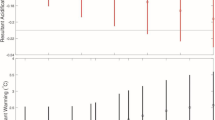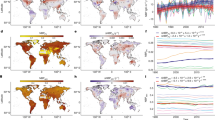Abstract
The threat of release of methane sequestered in the circumpolar Arctic regions of the world creates the possibility of triggering additional feedback effects from the terrestrial and the deep ocean systems which could potentially add large amounts of carbon (C) into the atmosphere. This paper analyses the implications for C mitigation policy under the threats of a substantial permafrost methane release. Several insights emerge from the analysis. First, the presence of non-linear feedbacks creates a bifurcation zone in the C emissions-stock space, on one side of which large accumulations of atmospheric C materialize leading to significant damages. Second, the bifurcation line does not have a steep slope, implying that it would be possible to avoid falling on the wrong side of this zone even if the current atmospheric stock of C were higher than what they are today. Third, when the release of permafrost C is uncertain, there is benefit in reducing anthropogenic C more than what would be optimal under a certain release of the same. Fourth, higher abatement cost scenarios do not necessarily imply significantly reduced abatement efforts. On the contrary, abatement efforts, which are only reduced marginally under this scenario, ensure that long run carbon path is stabilized. This is done in order to avoid incurring substantial costs of abatement in the future when non-linear feedback effects kick in.








Similar content being viewed by others
References
Archer D, Buffett B (2005) Time Dependent Response of the Global Ocean Clathrate Reservoir to Climatic and Anthropogenic Forcing. Geochemistry, GeoPhysics and GeoSystems, Vol. 6, No. 3
Detlef P, Van Vuuren J, Love ES, Gohar L, Hof AF, Hope C, Warren R, Meinshausen M, Plattner GK (2011) How well do integrated assessment models simulate climate change? Clim Chang 104:255–285. doi:10.1007/s10584-009-9764-2
Dietz S, Stern N (2008) Why economic analysis supports strong action on climate change: a response to the stern Review’s critics. Rev Environ Econ Policy 2(1):94–113
Dutta K, Schuur EAG, Neff JC, Zimov SA (2006) Potential C release from permafrost soils of Northeast Siberia. Glob Chang Biol 12:2336–2351
Enkvist PA, T Naucler, J Rosander (2007) A cost curve for greenhouse gas reduction, The McKinsey quarterly number 1, McKinsey & Company, pp 35–45
Friedlingstein P, Bopp L, Ciais P, Dufresne J-L, Fairhead L, Le Treut H, Monfray P, Orr J (2001) Positive feedback between future climate change and the C cycle. Geophys Res Lett 28:1543–1546
Harvey LD, Huang Z (1995) Evaluation of the potential impact of methane clathrate destabilization on future global warming. J Geophys Res 100(No. D2):2905–2976
IPCC (2007a) Climate Change 2007: Working Group I: The Physical Science Basis, url: http://www.ipcc.ch/publications_and_data/ar4/wg1/en/ch8s8-7-2-4.html
IPCC (2007b) Climate Change 2007: Working Group II: Impacts Adaptation and Vulnerability, url: http://www.ipcc.ch/publications_and_data/ar4/wg2/en/figure-20-3.html
Kriegler E, Hallc JW, Helda H, Dawson R, Schellnhubera HJ (2009) Imprecise probability assessment of tipping points in the climate system. PNAS 106(13):5041–5046
Keller K, Yohe G, Schlesinger M (2008) Managing the risks of climate thresholds: uncertainties and information needs. An editorial essay. Clim Chang 91:5–10
Koven CD, Ringeval B, Friedlingstein P, Ciais P, Cadule P, Khvorostyanov D, Krinner G, Tarnocai C (2011) Permafrost Carbon-Climate Feedbacks Accelerate Global Warming. Proceedings of the National Academy of the Sciences of the United States of America 108(36):14769–14774
Lawrence DM, AG Slater (2005) A projection of severe near-surface permafrost degradation during the 21st century. Geophysical research letter, p 32. doi:10.1029/2005GL025080
Lenton TM (2011) Early warming of climate tipping points. Nature Climate Change 1:201–209. doi:10.1038/nclimate1143
Mastrandrea MD, Schneider SH (2001) Integrated assessment of abrupt climatic changes. Climate Policy 1:433–449
Nordhaus WD (1993) Rolling the dice: an optimal transition path for controlling greenhouse gases. Resource and Energy Economics 15(1):27–50
Nordhaus WD (1999) The economic impacts of abrupt climate change, paper prepared for a meeting on abrupt climate change: The role of oceans, atmosphere, and the polar regions, National Research Council. Available at: http://nordhaus.econ.yale.edu/abrupt%20011998c.PDF
Reagan MT, G Moridis (2008) Dynamic response of oceanic hydrate deposits to ocean temperature change. J Geophys Res, p 113. doi:10.1029/2008JC004938
Scheneider B, M Latif, A Schmittner (2007) Evaluation of different methods to assess model projections of the future evolution of the atlantic meridional overturning circulation. J Clim 20(10):2121-2132
Schimel J (2004) Playing scales in the methane cycle: from microbial ecology to the globe. PNAS 101(34):12400–12401
Schuur EAG, Bockheim J, Canadell J, Euskirchen E, Field CB, Goryachkin SV, Hagemann S, Kuhry P, Lafleur P, Lee H, Mazhitova G, Nelson FE, Rinke A, Romanovsky V, Shiklomanov N, Tarnocai C, Venevsky S, Vogel JG, Zimov SA (2008) Vulnerability of permafrost C to climate change: implications for the global C cycle. BioScience 58:701–714
Schneider von Deimling T, Meinshausen M, Levermann A, Huber V, Frieler K, Lawrence DM, Brovkin V (2012) Estimating the near-surface permafrost-carbon feedback on global warming. Biogeosciences 9:649–665. doi:10.5194/bg-9-649-2012
Schuur EAG, Abbot B (2011) Climate change: high risk permafrost thaw. Nature 480:32–33. doi:10.1038/480032a
Tol RSJ (2008) The social cost of C: trends, outliers and catastrophes. Economics: the open access, Open-Assessment E-Journal, Vol. 2, Available at http://www.economics-ejournal.org/economics/journalarticles/2008-25.
Waelbroeck C, Monfray P, Oechel WC, Hastings SJ, Vourlitis GL (1997) The impact of thawing on the C dynamics of Tundra. Geophys Res Lett 24:229–232
Weitzman M (2009) On modeling and interpreting the economics of catastrophic climate change. Rev Econ Stat 91(1):1–19
Weitzman M (2010) What is the damages function for global warming—and what difference might it make? Clim Chang Econ 1(1):57–69
Weyant JP (2008) A critique of the stern Review’s mitigation cost analyses and integrated assessment, symposium: the economics of climate change: the stern review and its critics. Rev Environ Econ Policy 2(1):77–93
Wright EL, Erickson JD (2003) Incorporating catastrophes into integrated assessment: science, impacts and adaptation. Clim Chang 57(3):265–286
Zimov SA, Schuur EAG, Chapin FS III (2006) Permafrost in the global C budget. Science 312:1612–1613
Acknowledgement
This work benefited from numerous meetings and discussions held with Larry Karp over model formulation and empirical calibration. Any remaining flaws are author’s alone.
Author information
Authors and Affiliations
Corresponding author
Appendix: model calibration
Appendix: model calibration
1.1 Carbon feedback
Estimates of positive feedback to the atmospheric C from higher temperatures vary in the literature. Friedlingstein et al. (2001) obsaerve that climate change could potentially reduce land uptake of CO2 by 50 percent. For large climate sensitivities and large anthropogenic GHG emissions, the feedback could be around a factor of two (Harvey and Huang 1995; Archer and Buffett 2005). Based upon the above, we assume that, when atmospheric CO2 concentration is double the preindustrial levels of 280 ppm, non-linear feedback is 1 ppm, when atmospheric concentration is three times, feedback is 4 ppm and it is 5 ppm at four times the pre-industrial level. The calibrated parameter values for this relationship, specified in equation (1), are (see Fig. 9): \( {\eta_s}=4.8,\,a=8.96,\,b=2500 \)
1.2 Hazard function
The IPCC Fifth Assessment Report relies on four representative concentration pathways (RCP) which refer to the level of radiative forcing (in W/m2) brought about by the accumulation of C in the atmosphere by 2100. Schuur and Abbot (2011) derive low and high estimates of permafrost release based upon the RCP scenarios. These estimates are derived from a survey of 41 international scientists working on permafrost. The high warming scenario leads to a release of 63GT CO2 by 2040, 380GT CO2 by 2100 and 865GT CO2 by 2300. The low warming scenario leads to a release of 30GT CO2 by 2040, 232 GT CO2 by 2100 and 549GT CO2 by 2300.
While these estimates are deterministic, there is still a significant degree of uncertainty associated with the timing and extent of permafrost release. In this paper we also calibrate the risk of permafrost release through a hazard event. The hazard event represents a possibility of an additional release of 2 gtc emissions through melting of the permafrost.
Imagine if the CO2 stock remained fixed at 391 ppm, what would be the probability of the event happening in a century? If the stock were fixed at 560 ppm, what would be the probability of the event then? Based upon this criteria, the relationship between the probability, stock of C and hazard rate is derived as: \( p(s)=1-\exp \left( { - 100 \cdot h(s)} \right) \) where h(s) is calibrated at three levels of stocks of C: when the current ppm is 2 times, 2.5 and 3 times the pre-industrial levels, the probability of release by 2050 is assumed to be 0.75, 0.85 and 0.95. The hazard rate is calibrated to the functional form presented in equation (4). The calibrated parameter values are (see Fig. 10):
1.3 Damage function
The damage function is assumed sigmoid in the stock of C. It is calibrated in a way so that the doubling, tripling and quadrupling of the stock of C leads to 10, 30 and 40 percent loss in gdp respectively (see Fig. 11). Damage function is assumed to taper off to a level equal to 40 percent of the GDP at high levels of concentration to reflect the possibility that maximum possible damages to the GDP are less than 100 percent. The range of damages chosen here is higher than that shown in the IPCC working group II estimates, where a six degree increase in temperatures from the pre-industrial levels leads to about 15 percent of GDP loss (IPCC 2007b). The calibrated parameters based upon the functional form presented in equation (5) are:
We also consider a milder damage scenario (where the doubling, tripling and quadrupling of the stock of C leads to 10, 20 and 30 percent loss in gdp respectively). The calibrated function for this scenario is:
1.4 Abatement cost function
For the purposes of empirical estimation of abatement cost, abatement effort is measured not as a percentage of emissions but in absolute terms. Abatement cost estimates are derived, based upon the information in Table 1, so that cutting emissions by x ppm will lead to a cost of c(x) trillion dollars. Abatement cost function is calibrated as sigmoid to reflect possible cost savings from technological progress in future (see Fig. 12):
For the scenario where costs are assumed twice the above estimates, the parameter values are: \( {\eta_a}=4.3,\ {a_1}=10.35,\ {a_2}=400 \)
Rights and permissions
About this article
Cite this article
Ranjan, R. Optimal carbon mitigation strategy under non-linear feedback effects and in the presence of permafrost release trigger hazard. Mitig Adapt Strateg Glob Change 19, 479–497 (2014). https://doi.org/10.1007/s11027-012-9444-9
Received:
Accepted:
Published:
Issue Date:
DOI: https://doi.org/10.1007/s11027-012-9444-9








